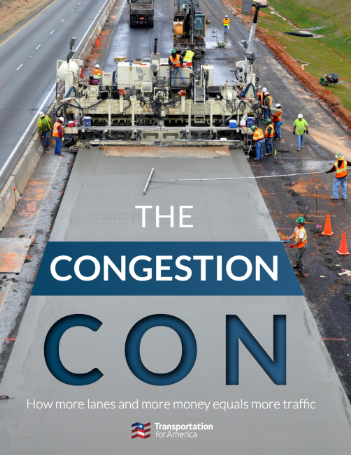From City Observatory:
You can spell congestion without “con.” Transportation for America has a new report that comprehensively skewers the highway engineer’s conventional wisdom about roads and traffic. Entitled “The Congestion Con: How more lanes and more money equals more traffic,” the report shows that contrary to common belief, we’ve been building roads faster than population has been growing, but the only result is to generate additional car travel and even more congestion. Our obsession with moving cars faster is at the root of these problems, as the report explains:
Car speeds don’t necessarily tell us anything about whether or not the transportation network is succeeding at connecting as many people as possible to the things they need, as efficiently as possible. Yet a narrow emphasis on vehicle speed and delay underlies all of the regulations, procedures, and cultural norms behind transportation decisions, from the standards engineers use to design roads to the criteria states use to prioritize projects for funding. This leads us to widen freeways reflexively, almost on autopilot, perpetuating the cycle that produces yet more traffic.
The culprit, as City Observatory readers know well, is induced demand, which comes in two waves. First, in most urban settings, when new capacity becomes available, motorists rapidly change their travel patterns to occupy it–nature abhors a vacuum, and cars fill empty urban road space. Second, and more insidiously, over a period of years, the pattern of land uses becomes progressively more sprawled, as people move to homes further from jobs, and as businesses decentralize. The result: everyone’s trips become longer and the entire area becomes even more car-dependent. And recurring congestion is then used as an excuse to build even more roads, repeating the cycle at ever larger costs (and scales). It’s a con-game that has hollowed out our cities, lengthened our commutes and menaces our planet.
The Congestion Con is a remarkably comprehensive synthesis of the case against road widening. It shows that we’ve spent nearly half a trillion dollars on roads, and congestion has only become worse. It explains in detail why engineer’s crude mental models, and the obsession with car speeds predictably produces strategies that make the problem worse. It dismantles the pseudo-science behind traffic delay measurements that are often used to justify highway widening. It’s a must, must read.
Here’s the beginning of the report:
Between 1993 and 2017, we added 42 percent more freeway lane-miles in the largest 100 urbanized areas, which significantly outstripped the 32 percent growth in population in those regions over the same time period. So congestion and delay went down, right? No, it exploded—up by a staggering 144 percent, far outpacing population growth. Not everyone was building roads at the same rate, but the story was the same all over the country:
Among urban regions with moderate or high population growth, some cities saw their populations grow at a much faster rate than freeway lane-miles, and also faced significant increases in delay—no big surprise. At the same time, however, freeway lane-miles were expanded a roughly equivalent pace as population growth in cities like San Diego, CA and Nashville, TN yet they saw larger increases in delay: 175 percent for San Diego and 329 percent for Nashville. Meanwhile, lane-miles were added at more than three times the population growth rate in places like Pensacola, FL and Omaha, NE yet delay still increased by 233 percent and 231 percent, respectively. And delay increased by an astonishing 446 percent in Boise, ID, where population grew by 117 percent and lane-miles grew by 141 percent. …in Jackson, MS, population grew by a comparatively low 9 percent and the region expanded its freeways at seven times that rate, yet delay increased by 317 percent. Buffalo, NY’s population dropped by 12 percent, and the region still faced a 175 percent increase in delay.
We are spending billions of dollars to widen or expand roads and seeing nothing logical or helpful in return. And yet we are continuing to double down on a strategy that isn’t working.
It’s been an expensive gambit. If you read Repair Priorities back in 2019, you might remember that states alone spent more than $500 billion on highway capital investments in urbanized areas between 1993-2017—much of that on expansion projects. States are on the hook for maintenance, which makes these expansions major financial liabilities now and for years into the future—something you’re unlikely to hear trumpeted by the elected leader promoting the latest big widening project. For roads already in good condition, it still costs approximately $24,000 per year on average to maintain each lane-mile in a state of good repair. The price tag just to maintain what we’ve already got is staggering.
If the “solution” to congestion isn’t working and we’re producing more liabilities than we can ever possibly afford to maintain, why continue plowing billions of dollars into this tactic?
Somebody needs to call a “time-out.”
Read more here.




